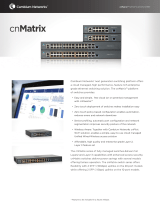
3
Features and Benefits
The EX2200-C model switches include a number of features that
make them ideal for low-density, open space deployments.
Compact Form Factor
At 10.6 inches wide and 9.4 inches deep, EX2200-C switches can
be easily and discreetly installed on desktops, on or under shelves,
or on walls. An optional magnetic mounting pad is available for
securing the EX2200-C switches to metal surfaces. Rack mount
kits are also available for installing the switches in standard 19
inch wiring racks. Wall mounting can be done using the flexible
mounting slots on the bottom of the chassis to fix to the screws
on the wall.
Dual-Purpose Uplinks
Two front panel, dual-purpose (10/100/1000BASE-T or
100/1000BASE-X) uplinks provide operational flexibility.
Silent Operation
The air-cooled EX2200-C switches do not require internal fans,
resulting in a silent operating mode suitable for deployments
in workgroup areas. The fanless design also reduces power
consumption and improves mean time between failures (MTBF)
by eliminating moving parts that can fail.
Low Power Consumption
The lack of an internal fan reduces the power consumed by the
EX2200-C switches. The hardware has Energy Ecient Ethernet
(EEE)-capable ports (with soware support available in a future
release), providing low power consumption when network link is idle.
Simplified Operations
When deployed in a Virtual Chassis configuration, the EX2200-C
dramatically simplifies network management. Up to four
interconnected EX2200-C switches can be managed as a
single device utilizing a single Junos OS image file and a single
configuration file, reducing the overall number of units to monitor
and manage. When the Junos OS is upgraded on the master
switch in an EX2200-C Virtual Chassis configuration, the software
is automatically upgraded on all other member switches at the
same time.
Dedicated front panel RJ-45 and USB console ports offer flexible
out-of-band management options, while a front panel USB
port can be used to easily upload the Juniper Networks Junos
®
operating system and configuration files. A series of front panel
LEDs offer system status information with a button that allows
users to toggle through four different modes for reporting link
status, link activity, PoE, and speed. A fixed internal power supply
ensures operational simplicity.
Easy Provisioning
Auto-configuration and Auto-Image Install features allow the
switches to be configured and imaged over the network using the
Dynamic Host Configuration Protocol (DHCP) message exchange
process. These features eliminate the need to stage devices prior
to deployment, dramatically reducing operational expenses.
Auto-configuration and Auto Image Install allow new branches
and retail stores to rapidly deploy their networks, and also enable
software upgrades and security fixes to be performed at the
touch of a button. An EZ touchless provisioning feature allows a
DHCP server to push configuration details and software images to
multiple switches at bootup.
Access Security
The EX2200-C switches fully interoperate with Juniper Networks
Unified Access Control, which consolidates all aspects of a user’s
identity, device, and location, enabling administrators to enforce
access control and security down to the individual port or user
levels. Working as an enforcement point within the UAC, the
EX2200-C provides standards-based 802.1X port-level access
control as well as L2-L4 policy enforcement based on user
identity, location, and/or device. If access is granted, the switch
assigns the user to a specific VLAN based on authorization levels.
The EX2200-C also provides a full complement of port security
features, including DHCP snooping, dynamic ARP inspection
(DAI), and media access control (MAC) limiting to defend against
internal and external spoofing, man-in-the-middle, and denial-of-
service (DoS) attacks.
In addition, the EX2200-C switches are hardware ready (with
software support available in a future release) to support IEEE
802.1ae MACSec, providing support for data confidentiality, data
integrity, and data origin authentication.
Video and VoIP Ready
The EX2200-C delivers a reliable platform for unifying enterprise
communication by providing the highest levels of flexibility and
features in its class for the most demanding converged data,
voice, and video environments. The EX2200-C switches support
plug-and-play deployment with industry-standard Link Layer
Discovery Protocol (LLDP) and LLDP-Media Endpoint Discovery
(LLDP-MED). LLDP-MED-based granular PoE management
allows the EX2200-C switches to negotiate PoE usage down to a
fraction of a watt on powered devices, enabling more efficient PoE
utilization across the switch.
In addition, the EX2200-C supports rich quality-of-service (QoS)
functionality for prioritizing data, voice, and video trac. The switches
support eight class-of-service (CoS) queues on every port, enabling
them to maintain multilevel, end-to-end trac prioritizations. The
EX2200-C also supports a wide range of policy options, including
strict priority, low latency, weighted random early detection (WRED),
and shaped deficit weighted round-robin (SDWRR) queuing.
Easy Cable Management
A cable guard that affixes to the front of the switch holds attached
cables in place and prevents them from being accidentally
unplugged or otherwise removed.
Physical Security
Security slots on either side of the switch accept locking devices
that physically secure switches, preventing them from being easily
removed in open space or unsecured environments
PoE/PoE+ Power Budget
The EX2200-C-12P-2G switch supports the IEEE 802.3af PoE
standard, as well as IEEE 802.3at PoE+. The 802.3af standard
delivers up to 15.4 watts of Class 3 PoE per port, while the 802.3at
PoE+ delivers up to 30 watts of power per port for supporting
networked devices such as telephones, video cameras, IEEE
802.11n WLAN access points, and video phones that require more
than 15.4 watts.
With a total PoE system budget of 100 watts, the 12-port EX2200-
C-12P-2G can provide the full 15.4 watts of Class 3 PoE to a
maximum of six ports simultaneously, and the full 30 watts of PoE+
to a maximum of three ports simultaneously. Attached devices
draw the necessary power until the PoE power budget is exhausted.








